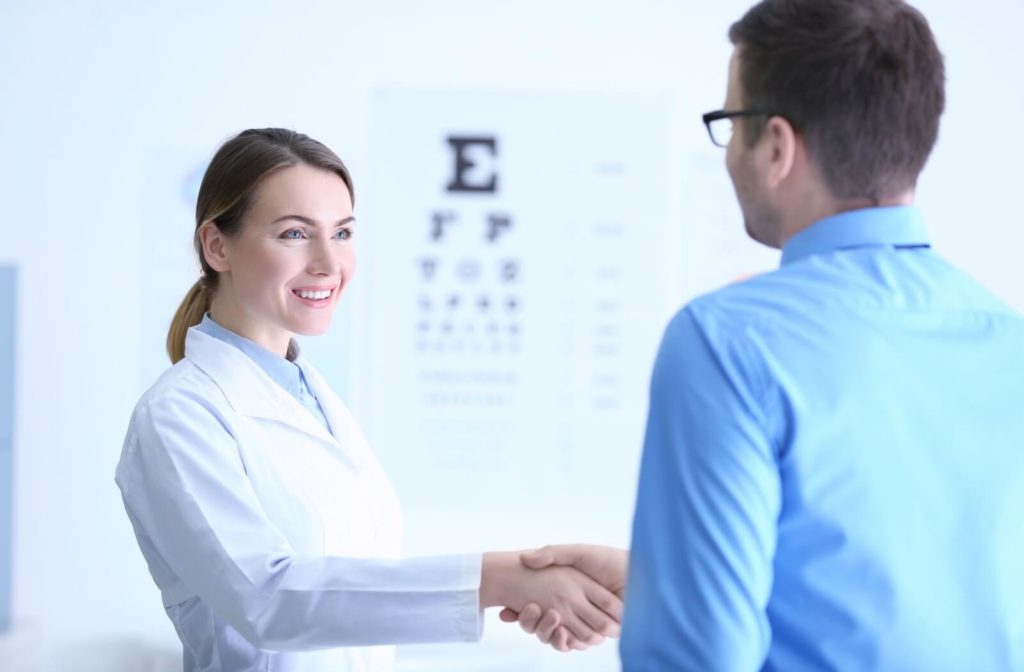Encountering a red, tender bump near your eyelid can be concerning. As uncomfortable as they can be, styes are not typically contagious. But even though they don’t usually spread, it’s crucial to take a few precautions, like not sharing anything face-related and following proper hygiene principles.
A stye will resolve itself in many cases following some basic at-home remedies that we’ll discuss in greater detail below. But it’s important to book an exam with your eye doctor if the stye persists or the discomfort becomes too great—it’s possible that it could be something else, like pink eye, as the two conditions have some similar symptoms.
Understanding Eye Styes
An eye stye, also known as a hordeolum, is a minor infection affecting the eye’s eyelash follicles or oil glands. While styes are generally harmless and resolve on their own, there could be instances where professional treatment is necessary.
Causes & Symptoms
The typical stye is triggered by an infection of the oil glands in the eyelids, primarily by Staphylococcus bacteria.
The symptoms are usually unmistakable—a red, swollen bump along the edge of the eyelid that resembles a pimple or boil. Other symptoms that can accompany the red bump include:
- Eyelid swelling—possibly the entire eyelid
- Discharge from the eye that forms crusting on the eyelid
- Sore or itchy feeling
- Light sensitivity
- Excessive tearing
- Feeling like there’s something in the eye
It’s important to see your eye doctor if you’re experiencing the persistence of these symptoms because they can resemble those of other eye conditions that may not go away without proper treatment.
Internal vs. External Styes
There are two types of styes: external and internal. It’s helpful to know the difference even though they present with similar discomfort and symptoms.
External styes originate from the base of the eyelash follicles, appearing on the eyelid’s surface. On the other hand, internal styes form on the inner side of the eyelid. While the location of the stye affects its appearance, the discomfort they bring is quite similar.
Are Styes Contagious?
Styes aren’t generally contagious. Bacteria often causes them, and it’s possible for small amounts of that bacteria to spread from them. This is a significant reason you should avoid touching the stye unless you’re cleaning it or using a warm compress—and always wash your hands before and after doing either of these things.
Routes of Transmission
Styes can spread through direct or indirect contact with the eyes. Common ways they can spread include sharing makeup and eyeglasses or through contact with contaminated objects.
Prevention & Management
Prevention is always ideal but not always possible. There are a few things you can do to minimize your risk and help speed up healing.
Hygiene Habits
Maintaining sound hygiene practices can deter stye transmission. Individuals should refrain from sharing personal eye items, regularly clean eye accessories, and avoid touching their eyes with unwashed hands.
Treating Styes
Using a warm compress with a clean cloth several times a day is a common at-home remedy for managing a stye. Regular washing with a mild soap, such as baby shampoo, or using an eyelid wipe is also important to aid healing and prevent transmission.
Styes that don’t respond to warm compresses and cleaning may require a visit to an eye doctor for draining. Your eye doctor may also use a steroid injection to help reduce swelling in some cases. Antibiotic ointment or cream could also be a potential treatment option.
Seeking Medical Help
Fortunately, a stye typically resolves without issue, but it’s important to know when to call your eye doctor. Visiting an eye doctor can provide clarity on the type of stye and the appropriate treatment options. Eye doctors can also guide individuals on the infectious nature of their stye and proper preventive measures for their specific case.
If the stye doesn’t improve within 48 hours or other symptoms accompany it, like severe pain, swelling, or difficulty seeing, it’s crucial to call your eye doctor. They may recommend that you come in for an emergency appointment to ensure there’s nothing vision-threatening going on.

Talk to Your Eye Doctor About a Persistent Stye
It’s important to remember that while spreading a stye is unlikely, it’s still possible. Good management and hygienic practices can minimize the risk. Proactive eye health practices not only help prevent transmission, but also promote general well-being. Keep a watchful eye on your ocular health and encourage others to do the same.
Call our team to book an appointment at Total Vision Lake Elsinore if you’re experiencing persistent and uncomfortable symptoms. One of our experienced eye doctors can look at your eyes and provide treatment advice for symptom relief.



